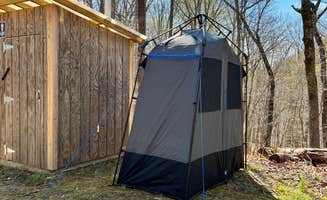Dispersed camping near Altenburg, Missouri extends into nearby Shawnee National Forest where primitive sites offer natural surroundings without developed facilities. The area experiences humid continental climate with summer temperatures regularly exceeding 90°F and winter lows below freezing. Most dispersed camping locations sit at elevations between 400-600 feet above sea level, creating moderate terrain with limited accessibility during wet conditions.
What to do
Hiking trails: Several miles of interconnected paths run through Panther Den Wilderness with natural rock formations and seasonal waterfalls. Visitors should carry adequate water supplies as no potable sources exist within the wilderness boundaries.
Fishing opportunities: Dutchman Lake Camp provides shore access for anglers seeking bass and panfish. "Great little spot right off the interstate. Lots of nice scenery and decent fishing," notes Jonathan H. in a recent review.
Wildlife observation: Trail of Tears State Forest contains diverse habitats supporting deer, turkey, and numerous bird species. "Excellent for tent camping when you want relatively easy access and still feel a bit of solitude," reports Bob P.
What campers like
Accessibility: Many dispersed sites near Altenburg offer relatively convenient access from highways while maintaining natural settings. Matthew Z. mentions Dutchman Lake Camp provides a "Beautiful spot with easy access and not far off the highway."
Solitude: The remote nature of these camping areas creates opportunities for peaceful experiences away from crowds. "Beautiful little spots as you come in. Quiet and easy to get too," according to J A., who camped at Dutchman Lake.
Natural surroundings: Undeveloped campsites integrate with the native forest environment, allowing for authentic outdoor experiences without artificial amenities or crowded campgrounds.
What you should know
Limited facilities: Most dispersed camping locations near Altenburg lack basic services. Plan to bring all necessary water, food, and waste disposal equipment. Trail of Tears State Forest provides some exceptions with basic amenities at certain sites.
Seasonal considerations: Spring brings potentially hazardous flooding in low-lying areas, while summer humidity creates uncomfortable conditions without shade. Fall offers moderate temperatures but requires preparation for sudden weather changes.
Navigation challenges: Many dispersed sites lack clear markers or designated areas. Bring detailed maps and GPS devices as cell service becomes unreliable in remote locations, particularly in wilderness areas.
Tips for camping with families
Safety preparation: Establish clear boundaries for children when camping in undeveloped areas. Limited emergency services mean bringing comprehensive first aid supplies and establishing communication plans.
Entertainment planning: Without developed recreation facilities, prepare nature-based activities for children including scavenger hunts, wildlife identification guides, and simple field equipment.
Site selection: Choose locations with natural barriers that create defined camping areas. Look for flat ground with adequate drainage and minimal hazards like deadfall trees or poison ivy patches.
Tips from RVers
Access limitations: Most dispersed camping areas near Altenburg restrict access to smaller vehicles due to narrow forest roads, low-hanging branches, and limited turning areas.
Leveling challenges: Bring additional leveling blocks as natural terrain rarely provides even surfaces for parking. Scout potential sites before committing larger vehicles to prevent difficult extraction situations.
Services planning: No hookups exist at dispersed sites, requiring complete self-sufficiency. The nearest dump stations and water fill locations may be 30+ miles away in larger communities, so plan tank capacity accordingly.


